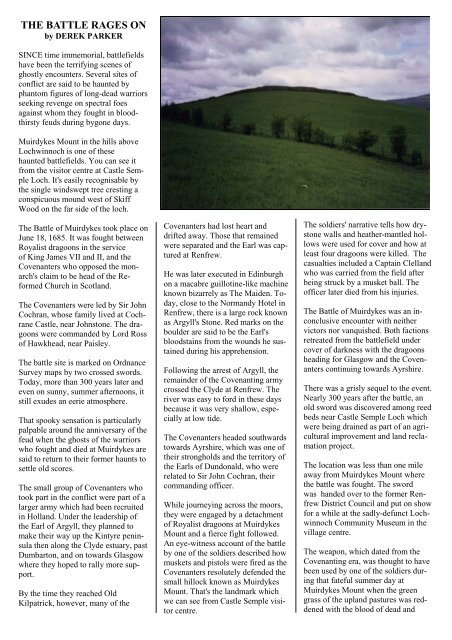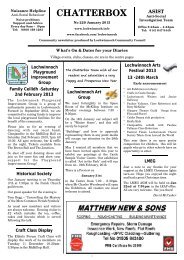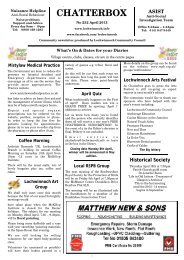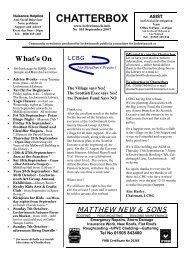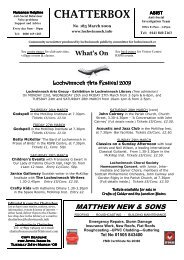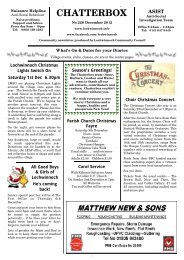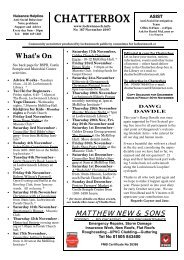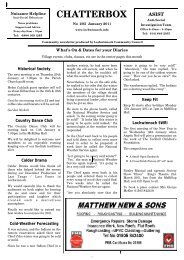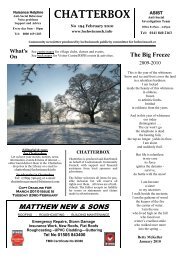aug-09 - Lochwinnoch Online
aug-09 - Lochwinnoch Online
aug-09 - Lochwinnoch Online
Create successful ePaper yourself
Turn your PDF publications into a flip-book with our unique Google optimized e-Paper software.
THE BATTLE RAGES ON<br />
by DEREK PARKER<br />
SINCE time immemorial, battlefields<br />
have been the terrifying scenes of<br />
ghostly encounters. Several sites of<br />
conflict are said to be haunted by<br />
phantom figures of long-dead warriors<br />
seeking revenge on spectral foes<br />
against whom they fought in bloodthirsty<br />
feuds during bygone days.<br />
Muirdykes Mount in the hills above<br />
<strong>Lochwinnoch</strong> is one of these<br />
haunted battlefields. You can see it<br />
from the visitor centre at Castle Semple<br />
Loch. It's easily recognisable by<br />
the single windswept tree cresting a<br />
conspicuous mound west of Skiff<br />
Wood on the far side of the loch.<br />
The Battle of Muirdykes took place on<br />
June 18, 1685. It was fought between<br />
Royalist dragoons in the service<br />
of King James VII and II, and the<br />
Covenanters who opposed the monarch's<br />
claim to be head of the Reformed<br />
Church in Scotland.<br />
The Covenanters were led by Sir John<br />
Cochran, whose family lived at Cochrane<br />
Castle, near Johnstone. The dragoons<br />
were commanded by Lord Ross<br />
of Hawkhead, near Paisley.<br />
The battle site is marked on Ordnance<br />
Survey maps by two crossed swords.<br />
Today, more than 300 years later and<br />
even on sunny, summer afternoons, it<br />
still exudes an eerie atmosphere.<br />
That spooky sensation is particularly<br />
palpable around the anniversary of the<br />
feud when the ghosts of the warriors<br />
who fought and died at Muirdykes are<br />
said to return to their former haunts to<br />
settle old scores.<br />
The small group of Covenanters who<br />
took part in the conflict were part of a<br />
larger army which had been recruited<br />
in Holland. Under the leadership of<br />
the Earl of Argyll, they planned to<br />
make their way up the Kintyre peninsula<br />
then along the Clyde estuary, past<br />
Dumbarton, and on towards Glasgow<br />
where they hoped to rally more support.<br />
By the time they reached Old<br />
Kilpatrick, however, many of the<br />
Covenanters had lost heart and<br />
drifted away. Those that remained<br />
were separated and the Earl was captured<br />
at Renfrew.<br />
He was later executed in Edinburgh<br />
on a macabre guillotine-like machine<br />
known bizarrely as The Maiden. Today,<br />
close to the Normandy Hotel in<br />
Renfrew, there is a large rock known<br />
as Argyll's Stone. Red marks on the<br />
boulder are said to be the Earl's<br />
bloodstains from the wounds he sustained<br />
during his apprehension.<br />
Following the arrest of Argyll, the<br />
remainder of the Covenanting army<br />
crossed the Clyde at Renfrew. The<br />
river was easy to ford in these days<br />
because it was very shallow, especially<br />
at low tide.<br />
The Covenanters headed southwards<br />
towards Ayrshire, which was one of<br />
their strongholds and the territory of<br />
the Earls of Dundonald, who were<br />
related to Sir John Cochran, their<br />
commanding officer.<br />
While journeying across the moors,<br />
they were engaged by a detachment<br />
of Royalist dragoons at Muirdykes<br />
Mount and a fierce fight followed.<br />
An eye-witness account of the battle<br />
by one of the soldiers described how<br />
muskets and pistols were fired as the<br />
Covenanters resolutely defended the<br />
small hillock known as Muirdykes<br />
Mount. That's the landmark which<br />
we can see from Castle Semple visitor<br />
centre.<br />
The soldiers' narrative tells how drystone<br />
walls and heather-mantled hollows<br />
were used for cover and how at<br />
least four dragoons were killed. The<br />
casualties included a Captain Clelland<br />
who was carried from the field after<br />
being struck by a musket ball. The<br />
officer later died from his injuries.<br />
The Battle of Muirdykes was an inconclusive<br />
encounter with neither<br />
victors nor vanquished. Both factions<br />
retreated from the battlefield under<br />
cover of darkness with the dragoons<br />
heading for Glasgow and the Covenanters<br />
continuing towards Ayrshire.<br />
There was a grisly sequel to the event.<br />
Nearly 300 years after the battle, an<br />
old sword was discovered among reed<br />
beds near Castle Semple Loch which<br />
were being drained as part of an agricultural<br />
improvement and land reclamation<br />
project.<br />
The location was less than one mile<br />
away from Muirdykes Mount where<br />
the battle was fought. The sword<br />
was handed over to the former Renfrew<br />
District Council and put on show<br />
for a while at the sadly-defunct <strong>Lochwinnoch</strong><br />
Community Museum in the<br />
village centre.<br />
The weapon, which dated from the<br />
Covenanting era, was thought to have<br />
been used by one of the soldiers during<br />
that fateful summer day at<br />
Muirdykes Mount when the green<br />
grass of the upland pastures was reddened<br />
with the blood of dead and


